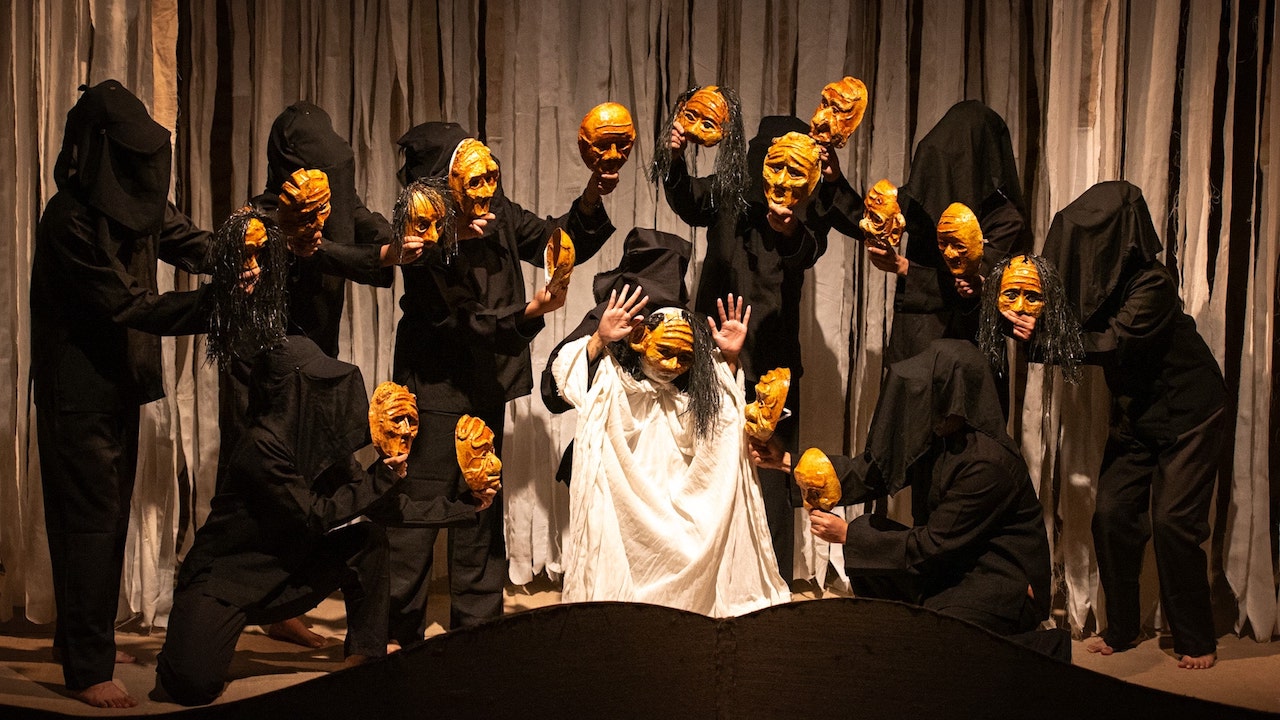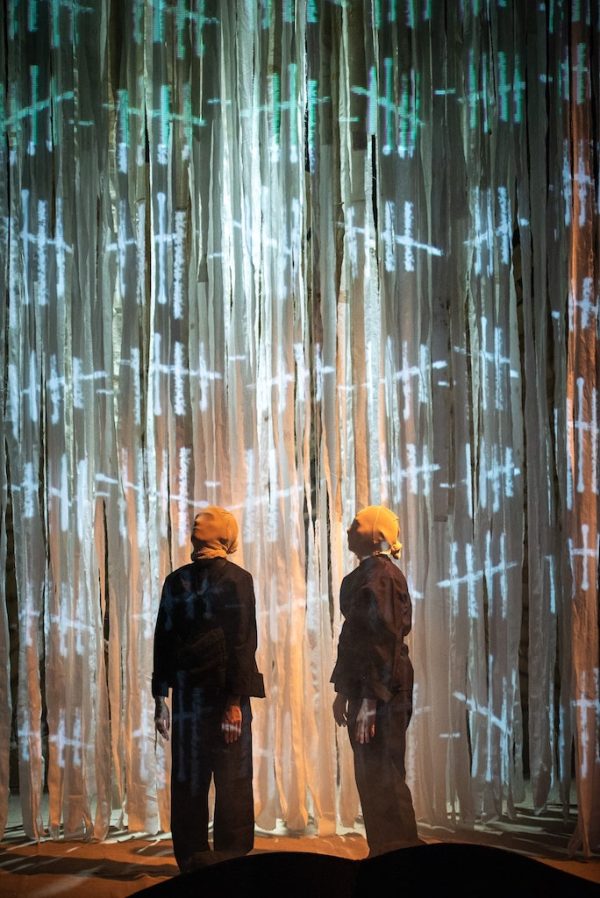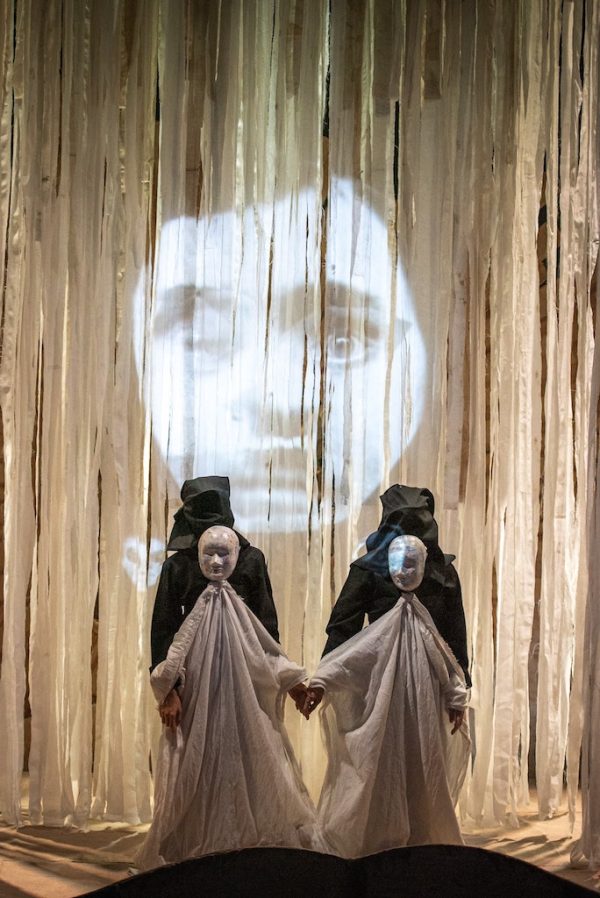
REVIEW: ‘Puting Gunaw’ is a haunting if frustrating puppetry experience
The new, non-traditional puppet show from Teatrong Mulat ng Pilipinas is an urgent, unsettling protest against war that’s also difficult to grasp.
As exciting as it is to get blockbuster theater shows every month, let it not be forgotten that some of the strangest and most daring material also continues to be experimented with by smaller companies, community theaters, and student organizations. At the Amelia Lapeña-Bonifacio Teatro Papet Museo, Teatrong Mulat ng Pilipinas conducted a particularly unique if flawed experiment for a single weekend: a twin bill production entitled Tabula Rasa, featuring a rerun of their inspired Prinsipe Bahaghari, and the new Puting Gunaw—itself an adaptation by Vladimeir Gonzales of Lapeña-Bonifacio’s White Holocaust or A Pacific Playwright’s Protest Against the Bomb. Less a traditional puppet show than a piece of protest theater told through puppetry techniques, the one-hour play is as urgent and unsettling as it is difficult to grasp.
An Eerie Reality

Photo Credit: Vladimeir Gonzales
Rather than employing the use of miniature puppets operated with strings or rods, Puting Gunaw and its puppet designer Harvey Sallador have the performers (mother-daughter team Amihan Bonifacio-Ramolete and Aina Ramolete, who also serves as director and production designer) cover themselves entirely in black. They then attach masked mannequin heads and white sheets of cloth to their chests, allowing them to play various characters by picking up new masks or spreading the cloth wide with their hands. Once in a while, even more performers take the stage to assemble little shadow puppet scenes (designed by Sigmund Pecho) that play out on the sides.
Taken with Ohm David’s set—strips of more white cloth unfurled from the ceiling, forming a thick, jagged backdrop—as well as Andrei Fabricante’s lights and Steven Tansiongco’s video projections, Puting Gunaw becomes a show of eerie, deliberately distorted apparitions. There’s always a sense that what we’re seeing is only ever a vague approximation of reality; or darker, that everything has been corrupted by something that only seems to keep growing or increasing in number.
Beyond Mere Spectacle
Without any live dialogue or real faces to see on stage, the performance of Puting Gunaw relies heavily on JM Cabling’s movement design. And while the puppeteers’ are clearly limited in the ways they can express themselves, there’s still a ghostly quality to the way they make their characters move. Whereas the charming puppets of Prinsipe Bahaghari scurry about the stage in little steps, the characters here glide and hover above the ground.
Puppet theater on larger stages around the world tends to aim for innovation by making puppetry more invisible; the more that they can make sophisticated movements more seamless, the better. The puppetry in Puting Gunaw is understandably much more crude in comparison, but it serves a purpose beyond mere spectacle. Whether intentionally or not, you always remain cognizant of the puppeteers proverbially pulling the strings; the point here isn’t for them to disappear. The result is a sort of out of body experience where you’re watching both a performance and the making of that performance at once.
Impassioned but Obscured

Photo Credit: Vladimeir Gonzales
But where Puting Gunaw obscures its ideas perhaps too much is in its writing. Playing out as a restless stream of consciousness, the production simulates the experience of having every idle thought, every social media post, and every seemingly unrelated topic of conversation inevitably relating back to war and violence—particularly, the red-tagging and subsequent murder of Filipino activists, and the ongoing genocide of Palestinians at the hands of Israel. The play grapples with the impossibility of comprehending this much unimaginable bloodshed alongside our own everyday existence.
Still, it doesn’t quite engage with its subject matter beyond the accumulation of individual experiences and headlines. The plea that it makes—that enough is enough—is honest and impassioned, but also misses the opportunity to clarify its points towards an understanding of these structures of violence, or how we can move past collective bystander paralysis. The reasoning that some conflicts are too “complicated” to understand or care about has long been used to keep people silent, when the reality should actually be simple to comprehend: that one far more powerful aggressor is indiscriminately killing masses of people. Puting Gunaw is clearly knowledgeable about all of this, but its abstraction of these ideas may only distance them further away from people. And yet, that it speaks about these conflicts at all, when some larger theater companies would never dare, is worth all admiration.
Tickets: P800 – P1,500
Show Dates: July 12–14 2024
Venue: Amelia Lapeña-Bonifacio Teatro Papet Museo, Diliman, Quezon City
Running Time: 1 hour (without intermission)
Credits: Amelia Lapeña-Bonifacio (Playwright), Vladimeir Gonzales (Adaptation), Aina Ramolete (Direction, Illustration, Production Design, Puppeteering), Amihan Bonifacio-Ramolete (Puppeteering), JM Cabling (Movement Design), Sigmund Pecho (Shadow Puppet Design), Steven Tansiongco (Video Design), Ohm David (Set Design), Arvy Dimaculangan (Music & Sound Design), Harvey Sallador (Puppet Design), Andrei Fabricante (Lighting Design)
Company: Teatrong Mulat ng Pilipinas


Comments